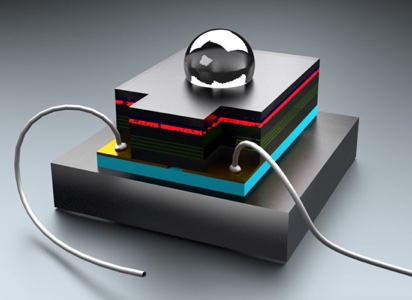Semiconductor quantum dots are nanoscale structures which create a highly confined trap for particles such as electrons, holes, and excitons (strongly bound electron-hole pairs). A single exciton can recombine to generate a “fast” (~ 1 ns lifetime) single photon that is highly coherent (near the Fourier transform limit). Individual electron or hole spin states can also be linked with the polarization of the photon to encode quantum information. Due to the ease of incorporating heterostructure functionality (to enable deterministic charge control and electrical tuning of the optical properties) and monolithic photonic devices (for increased light-matter interaction efficiency), quantum dots therefore make nearly ideal single photon sources which have much to offer future quantum technologies.

Electron microscope view of quantum dots. Quantum dots can host a single electron or hole spin that can be addressed optically.
Using quantum dots, we address the following challenges:
- What are the fundamental limits to coherence in a quantum dot? How perfect can a source of on-demand indistinguishable single photons be? Can we engineer the spin / exciton coherence – or at least mitigate the most relevant dephasing mechanisms? Relevant publications: Phys. Rev. Lett. 116, 257401 (2016); Phys. Rev. Lett. 123, 167402 (2019).
- Can we discover new techniques to optically and electrically generate and coherently control indistinguishable single photons? Relevant publications: Optica 3, 493 (2016); Phys. Rev. Lett. 126, 047403 (2021)
- Bright quantum dot sources have applications in quantum communications and networking. Unfortunately, the highest quality InAs/GaAs self-assembled quantum dots emit typically between 900 and 1000 nm, far from ideal for long-distance communication. Can we generate high quality (indistinguishable) single photons at telecom wavelengths by using frequency down-conversion techniques? Can we devise new quantum secure protocols for quantum communications with high-brightness telecom sources? Can the spin-photon link and coherence be preserved at telecom wavelengths? Can we interface the single photons with disparate systems for hybrid approaches in quantum science? Relevant publications: Appl. Phys. Lett. 118, 174003 (2021); Nature Comms 14, 3573 (2023).
- How can we achieve scalability, moving from just one single photon source to many? What approaches can we use to multiplex multiple single photon sources? How can multiple indistinguishable quantum dots be interfaced? What are the quantum optical properties (including superradiance and cooperative emission) of multiple indistinguishable single photon sources? Relevant publications: Phys. Rev. Appl. 14, 034011 (2021); Sci. Adv. 8, eabm8171 (2022); Phys. Rev. A 107, 023718 (2023)
Our work on these topics is enabled by established collaborations with the groups of Erik Gauger, Alessandro Fedrizzi, and Mehul Malik.
